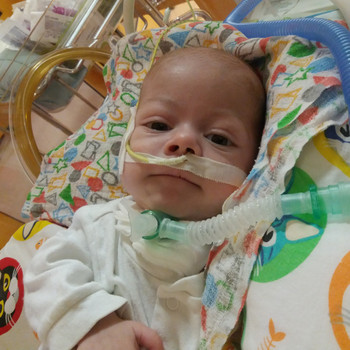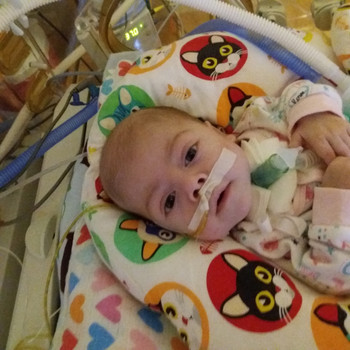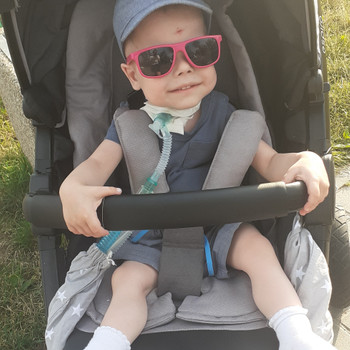Witold’s Journey: A Brave Heart in a Small Chest.1677
Hi! My name is Witold, and I’ve been fighting for every breath since the day I was born. I was born with a very rare condition called constrictive thoracic dysplasia, a disorder that has shaped every moment of my life. My chest is unusually narrow, which makes breathing incredibly difficult. Respiratory failure has been the greatest threat to my life, and from the very beginning, every breath I take has been a battle.
Since September 2017, I’ve been connected to a tracheostomy tube, a lifeline that has helped me avoid the repeated bouts of pneumonia that plagued my earliest days. Before the tracheostomy, infections were frequent and often dangerous, leaving my family and doctors in constant worry. Despite these challenges, my parents never gave up, and their unwavering dedication has carried me through the darkest times.

My journey has not been simple. I have faced countless obstacles—liver failure, kidney stones, and feeding difficulties that led to the placement of a gastroenterology tube (PEG) in January. For almost nine months, I remained in the hospital under constant care, surrounded by machines and monitors, until the day finally came when I returned home. On March 21st, a bright and sunny day, I was brought home by ambulance, connected to a ventilator, where my parents and two loving sisters were waiting. That day marked the beginning of a new chapter, a chapter filled with hope, care, and the struggle for every breath.
Even at home, my condition required constant support. I continue to rely on a ventilator, and my small size—at age two, I weighed only 5.5 kg (11.2 lbs)—makes every movement and every moment a challenge. Yet my spirit has remained strong. I am under the care of many specialists who guide my treatments, monitor my progress, and help my family navigate the complexities of my condition.

After months of uncertainty, my doctors decided I could undergo chest augmentation surgery. The procedure was risky but necessary, designed to increase the volume of my chest and allow my lungs to function better. The first surgery increased my chest volume only slightly, and the second surgery followed. But then the pandemic struck, forcing my family into isolation once again, and progress was slow. Even today, at the age of six, I stand at just 92 cm tall, with immobile intercostal muscles that make me more vulnerable to respiratory failure. My chest has grown only a little, but my determination to live and thrive has grown immensely.
In 2023, I faced one of my most dangerous challenges yet. I contracted a severe pneumonia that left me in a medically induced coma. My lungs were failing, my vital signs indicated sepsis, and my kidneys began to fail. For sixteen days, I fought for my life in the intensive care unit, followed by twenty-five more days in a pediatric ward under constant monitoring. The pneumonia left a permanent mark on my lungs—fibrosis—which cannot be reversed. Yet today, my respiratory function is stable, a testament to my resilience and the tireless dedication of my family and medical team.

My journey is ongoing, and while progress has been slow, I continue to grow stronger every day. I am small in stature, but my courage is enormous. Every day brings new challenges, from physical therapy to speech therapy, to maintaining my respiratory support. Every milestone—every breath, every smile, every small achievement—is a victory worth celebrating.
My parents and sisters have stood by me through it all, fighting for each step forward and every moment of life that was never guaranteed. They have shown me the meaning of love, perseverance, and hope. And through the generosity and support of countless friends, family, and strangers, I have received the care, equipment, and therapies that allow me to face each day with courage.

Time has taught me to be strong, to fight, and to never give up. Despite every obstacle, I continue to face life head-on. My chest may be small, my body fragile, but my spirit is unbreakable. With your support, I can continue my journey, access the treatments I need, and embrace every new day as a chance to grow, breathe, and live fully.
From the bottom of my heart, thank you for being part of my story and helping me fight for every breath.

The Man Who Saved the Drowning Bear: Courage Beneath the Bridge.53

The river ran dark and cold beneath the bridge that morning — its current fast, its surface glinting in fragments of gray light. A crowd had gathered above, watching in shock and helplessness as a massive
Moments earlier, wildlife officers had shot the animal with a tranquilizer dart after it wandered too close to a residential area. But the dosage was too strong, or perhaps the bear had moved too soon — whatever the reason, the sedative hit its bloodstream faster than expected. Within minutes, its powerful limbs began to weaken, its body twisting helplessly in the current.
The bear’s head dipped once. Then again. The crowd gasped. Each time it resurfaced, the water rushed into its nostrils, and its dark eyes glazed with panic. There were shouts, phones recording, a few people calling for help — but no one moved. The river was deep, cold, and fast.

No one, that is, except one man.
Ivan Stepanov, a visitor from Russia on a work trip, had stopped on the bridge out of curiosity when he saw the commotion. He looked down, saw the bear slipping under the surface — and without a second thought, began to strip off his shoes and jacket. Someone yelled after him, “Don’t do it! You’ll die!”
But Ivan didn’t hesitate. He just said, “He’s alive. That’s enough.”
Then he jumped.
The water was shockingly cold — the kind of cold that steals breath and numbs thought — but Ivan kicked hard, fighting the pull of the current. The bear was drifting, half-conscious, its head barely above the surface. For a terrifying moment, Ivan thought he was too late. But then, through the churning water, he saw a faint movement — a twitch of the paw, a bubble of breath.
“I’m here,” he called out instinctively, his voice swallowed by the river. “You’re not alone.”
He reached the animal and looped one arm under its massive neck. The bear was heavy, its fur waterlogged, its body limp. But Ivan held on. Slowly, painfully, he began to drag it toward shore, whispering in Russian — words of calm that neither of them could fully understand but both somehow needed.
The crowd above had fallen silent. Every eye followed the impossible sight: a man, barely visible through the spray, holding the head of a sedated predator above the waterline. For every inch he gained, the current pulled back harder. His muscles screamed. His chest burned. But he refused to let go.
At last, after what felt like an eternity, Ivan’s feet touched the muddy bank. He stumbled, gasping, his arms still wrapped around the animal’s neck. A wildlife officer waded in to help, and together they hauled the bear onto solid ground.
The rescuers quickly began their work. They checked its breathing, cleared the water from its nostrils, and administered an antidote to the tranquilizer. For a long moment, nothing happened. Then the bear’s chest rose, fell, and rose again. Its eyes flickered open, dazed but alive.
A cheer erupted from the bystanders.
Ivan sank to his knees, utterly spent, his clothes drenched and clinging to his skin. One of the officers turned to him and said, “You could have been killed. Why would you risk your life for a bear?”
Ivan smiled faintly, his breath still uneven. “Where I come from,” he said softly, “a man’s strength is measured by who he chooses to protect — even if it has claws.”
Later, after the bear was released safely back into the wilderness, locals began calling it “Stepan,” after the man who saved it. The story spread across the world — not because of the danger or the drama, but because of something simpler: the reminder that compassion doesn’t stop at species, language, or fear.
When asked again about that day, Ivan said he didn’t see himself as a hero.
“I just saw a creature in trouble,” he said. “And if you can help, you do. That’s all.”
Maybe that’s how courage truly works. It doesn’t shout or plan or weigh the odds. It simply acts — even when the water is cold, the current strong, and the thing you’re saving could, in another moment, destroy you.
That day beneath the bridge, in the icy rush of a Kansas river, one man’s heart proved stronger than fear.
And somewhere deep in the wilderness, a black bear still breathes because of it.





